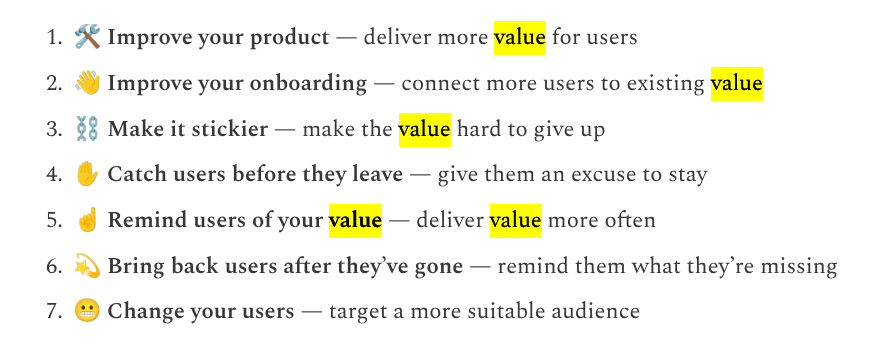Think back to learning how to ride a bike 🚲.
🩹 Scraped knees, bruised elbows, moments of panic. Sometimes you’d hit the ground hard — bleeding, sobbing, yet keeping a strong face, masking your hurt, or even crying out loud when the frustration boiled over.
Not every child had to learn this way though. Some were given training wheels or tricycles — tools that didn’t remove the challenge, but paced it. They eased you into the experience, familiarizing you with the road, giving you glimpses of what riding freely could feel like. That early sense of progress wasn’t fake — it was foundational. The result? A confident rider. Same destination, less pain. The journey felt entirely different.
Now, imagine your product is that bike.
Are you building something that makes people grit their teeth just to get through the setup? Or are you guiding them, teaching them balance, giving them little wins that lead to big ones?
The question isn’t whether users use your product. It’s whether they arrive with momentum — or with battle scars.
🪓 “Conversion rate doesn’t tell you the truth you need to hear.”
Focusing on conversion metrics isn’t inherently wrong — they’re essential to understanding business outcomes. But where product teams often misstep is in how they build toward those conversions. Many teams, in their aim to “deliver value”, treat user friction as an afterthought — something to smooth out later, once the “MVP” is out the door.
That mindset is what undermines true product success. Friction isn’t something to patch after launch; it’s something to invest in from the start. It determines whether your users feel joy when they use your product — or have their life sucked out of them trying to consume the so-called value.
Agile isn’t about shipping fast — it’s about delivering value fast. And if your product hurts to use, the value never really lands. It’s like serving a bowl of nuts to a starving allergic — well-intentioned, but deadly.
True agility — and long-term product success — comes not just from delivering core functionality, but from minimizing friction early.
🔍 Conversion May Tell You What Happened — But Attempts Tell You How
Imagine a user trying to sign up for your product. They run into an error, try again, re-enter information, refresh the page, try a different browser, finally succeed… and then you log it as a successful convert.
Technically, yes — they converted. But you wouldn’t be happy with a store that made you crawl through glass just to get in. You want to make your product as accessible as possible. From the very first click.
To fix friction, we need to first recognize it. Not all friction shows up as a support ticket or a drop-off. Sometimes, it hides in the effort users expend — the number of times they try before succeeding.
This is where attempts per conversion becomes a critical metric. It shifts the lens from outcomes to effort. A high number of retries, failed form submissions, misclicks, or support chats — even among converted users — signals hidden friction.
That said, we don’t want to remove all friction. Friction makes the wheel turn — but too much, and it locks up entirely. Similarly, when friction in your product crosses a threshold, it erodes trust. Trust that your product can meaningfully deliver what it promises.
⚙️ Friction as a Leading Indicator
Conversion is a lagging indicator — a snapshot of the past. Friction, on the other hand, gives you foresight. It shows you what users are struggling with right now, before it affects your retention or growth.
Let’s look at some useful ways to measure friction:
- Time to Value (TTV): How long does it take users to get to their first “aha” moment?
- Customer Effort Score (CES): How easy did they find it to complete a task?
- Behavioral friction signals: Rage clicks, repeated backtracking, session recordings showing hesitation or confusion.
When you start tracking these, patterns emerge. Drop-offs in onboarding, users abandoning forms, or high usage of support links indicate that something isn’t clicking.
Lenny Rachitsky — former Airbnb product lead and author of a popular product management newsletter — often emphasizes optimizing onboarding not to boost conversion, but to speed up value delivery. Because that’s what keeps people around (source: https://www.lennysnewsletter.com/p/how-to-increase-your-retention-issue).
 Source: How does one improve Retention from LennysNewsletter.com
Source: How does one improve Retention from LennysNewsletter.com
By treating friction as a real-time, quantitative signal — not an anecdotal complaint — you start building proactively.
If you only look at conversion, you’ll always be reacting. Friction lets you get ahead of the drop.
🚀 Reducing Friction Early Leads to More Agile (and Valuable) Products
There’s a myth that polishing UX is something you do after product-market fit. That MVPs are supposed to be rough — and friction is just part of the early hustle.
That mindset is fundamentally flawed and misrepresents the principles of Agile development, which emphasize delivering value to users early and often — not just speed at the cost of usability.
Marty Cagan teaches that usability is one of the four core product risks (source: https://www.svpg.com/four-big-risks/). If people can’t use what you built, nothing else matters. What’s more — fixing UX later is far more expensive.
Agile is not “ship fast at all costs.” Agile is learning fast. And friction that blocks learning — like confusing flows, excessive form fields, or unhelpful error messages — slows your learning loop down.
So no, you don’t have to design the perfect experience from Day One. But you do have to notice where you’re losing people unnecessarily. Because the longer you ignore those lessons, the more expensive they get.
The fastest path to delivering value faster is reducing the reasons your users slow down.
🧭 The Invisible Cost of Conversion
Conversion rates are the loudest number in the room — but they rarely reveal the full story behind user effort, confusion, or frustration. If users are pushing through frustration just to “convert,” then what you’re really measuring isn’t success — it’s survival, despite your product.
Friction is the early signal your product is either flying or failing, long before the revenue graphs catch up.
But let’s be clear: this isn’t about removing all friction. It’s about removing the friction you created — unintentionally, by rushing, or by ignoring the emotional weight of first impressions.
So here’s the challenge: stop asking “Did they convert?” and start asking “What did it cost them to convert?”
Don’t wait for friction to show up in churn reports. Measure it. Analyze it. Design against it — from Day One.
Because the products that win aren’t the ones that get adopted quickly.
They’re the ones that feel effortless once they do.
Useful links:
https://www.lennysnewsletter.com/p/how-to-increase-your-retention-issue
https://www.svpg.com/four-big-risks/
https://sergioschuler.com/your-product-team-might-use-agile-but-it-is-not-agile-936d67c2ecb0
https://medium.com/pinterest-engineering/lessons-in-growth-and-increasing-signups-d6e7d8fef479
https://www.crazyegg.com/blog/usability-testing/
https://www.nngroup.com/articles/satisfaction-vs-performance-metrics/
https://www.nngroup.com/articles/product-ux-benchmarks/
https://docs.mixpanel.com/docs/features/advanced#frequency-per-user
https://docs.mixpanel.com/docs/features/advanced#analyzing-first-time-users
https://userpilot.medium.com/drop-off-analysis-how-to-find-friction-points-13b9f0bf520a


